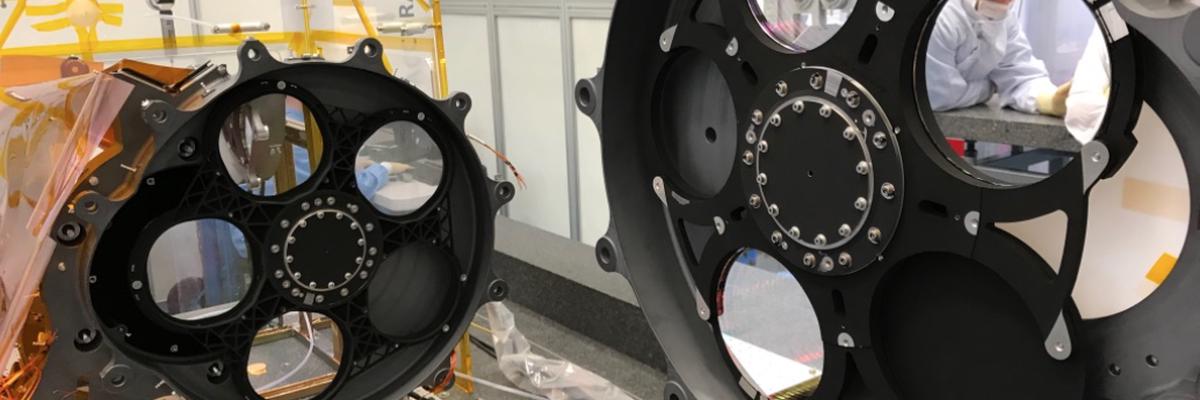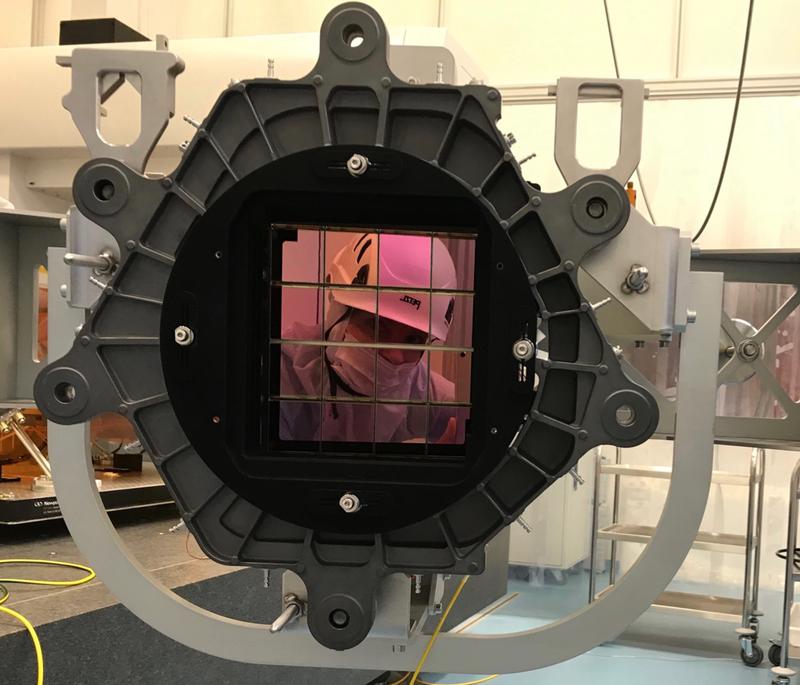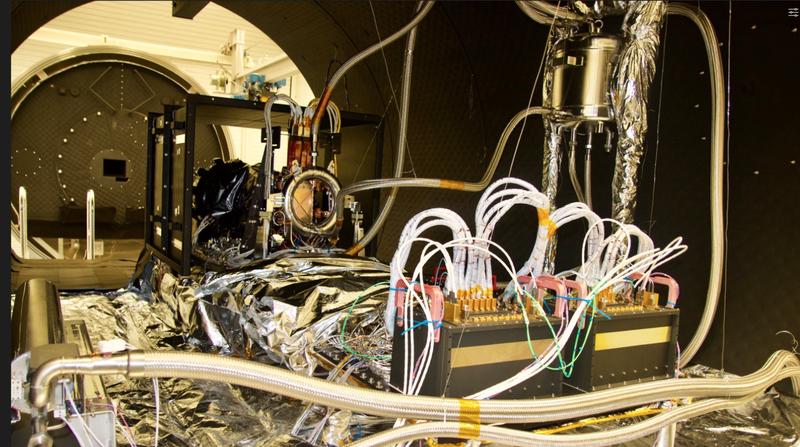Highlight
Euclid space telescope’s Near-Infrared instrument ready to draw a 3-D map of galaxies of the distant Universe
July 9, 2020

ESA’s Euclid mission to study more than a billion galaxies is a step closer to launch as its two instruments are now built and fully tested, including the complex near Near-Infrared Spectrometer and Photometer (NISP) instrument delivered by an international consortium coordinated by France, with partners from Italy, Germany, Spain, Denmark, Norway and the United States.
Once Euclid is launched from French Guiana in 2022, the NISP instrument will feed the world largest near infrared wide field camera put into space and will deliver near-infrared photometry, spectra and redshifts of tens of million distant galaxies providing a detailed description of the 3-dimensional structure of the universe, and its evolution as function of look back time.
Euclid has a 1.2-metre mirror telescope that is designed to work at both visible and near- infrared wavelengths. It will collect light from distant cosmic objects and feed it into NISP and the second instrument, the VISible instrument (VIS), both working in parallel and observing the exact same regions of the sky at each exposure of the telescope. Euclid will survey the 3-D distribution of galaxies and dark matter and map the geometry of the Universe with the aim of making accurate measurements of the mysterious Dark Matter and Dark Energy, which make up most of the cosmos. No-one yet knows what Dark Energy is, and Euclid will be the yet most powerful tool for cosmologists and astronomers looking to find out.

Dr Yannick Mellier (Institut d’Astrophysique de Paris, CNRS/Sorbonne Université and CEA/IRFU, Saclay), lead of the 1500-strong Euclid Consortium of which NISP is a part, said “Euclid will revolutionise our knowledge of the Universe by making the most accurate measurements of Dark Matter and Dark Energy, testing whether Einstein’s theory of General Relativity requires modification, weighing neutrinos, and exploring the details of how galaxies evolve.” NISP is composed of several subsystems that were designed, built, and tested by a team of astronomers and engineers from several laboratories of the Euclid Consortium with the help and supports from the Centre National d’Etudes Spatial (CNES, France), the Astronomy and Particle Physics Departments of the Centre National de la Recherche Scientifique (CNRS, France),the Institute for Research on the Fundamental laws of the Universe (IRFU) Research Division of the Commissariat à l’Energie Atomique (CEA, France), the Agenzia Spaziale Italiana (ASI, Italy), the Istituto Nazionale Astrofisica (INAF, Italy), the Istituto Nazionale di Fisica Nucleare (INFN, Italy), the Deutsches Zentrum für LuftundRaumfahrt (DLR, Germany), the Max-Planck-Institut für Extraterestrische Physik (MPE, Germany), the Max-Plank-Institut für Astronomie (MPIA, Germany), the Ministerio de Economia y Competividad (MINECO, Spain), the Insitut de Física d’Altes Energies - The Barcelona Institute of Science and Technology (IFAE-BIST, Spain) and the Instittut d’Estudis Espacials de Catalunya - Institut of Space Science (IEEC-ICE-CSIC, Spain), Universidad Politecnica de Cartagena (Spain), the University of Oslo (UiO, Norway), the Norwegian Space Agency (Norway), the Niels Bohr institute (Denmark), the technical University of Denmark (DTU, Denmark), and NASA / JPL (USA).
Thierry Maciaszek (CNES/LAM), NISP instrument project manager, said, “The international NISP team in the Euclid Consortium and industries has made an incredible quasi perfect job to design, develop and test this challenging complex instrument. The delivery of NISP is however not the end of the story for the NISP team. Many major activities have to be completed with NISP at satellite level. We are looking forward to seeing the first light in flight demonstrating the excellent performances of the instrument.” NISP was designed, built and tested under the lead of the Laboratoire d’Astrophysique de Marseille (LAM, France). The NISP instrument consists of three main assemblies:
The NISP Opto-Mechanical Assembly (cooled to 130K) made of:
- A silicon carbide structure, developed by LAM,with elements provided by UiO, supporting the different NISP subsystems and interfacing with the Euclid Payload module
- The NISP Optical Assembly (built by MPE) made of a Correction Lens and a 3-lens focusing optics
- Three near infrared Y,J, and H broadband filters(MPIA) are mounted on a dedicated rotating wheel (IFAE, IEEC,ICE-CSIC & CEA/Irfu)
- Four near infrared grisms developed by LAM(grism is a grating and a prism used for spectrometry) are mounted on a dedicated rotating wheel (INAF and CEA/Irfu)
- A calibration Unit having 5 near-infrared LEDs (MPIA)
The NISP detector system, composed of:
- 16 high quality detectors cooled to 95K(NASA/ESA).
- 16 electronics dedicated to detector controlling (NASA/ESA)
- A detector/electronic support structure (LAM)
The NISP warm electronic units composed of:
- The Instrument Control Unit (Universidad Politecnica de Cartagena and Instituto de Astrofísica de Canarias, Spain. The software of the ICU is developed by INAF.
- The Data Processing Unit managing the detector electronics and performing detectors onboard data processing (ASI, OHB-I, SAB,TEMIS). The software of the DPU has been developed by INAF.
The detector system has been deeply characterized in Europe by the Centre de Physique des Particules de Marseille (CPPM) and the Institut de Physique des 2 Infinis de Lyon (IP2I). The NISP integration and cold functional / performances tests were performed at LAM in a large cryochamber, in collaboration with all the partners. A complex optical setup has been developed by LAM and Niels Bohr / DTU institutes for the NISP cold performance verification. The NISP ground commanding setups are under INAF/INFN responsibility. The NISP vibration testing were done at the Centre Spatial de Liège (CSL, Belgium).

Dr Anne Ealet, NISP Spectroscopy Instrument Scientist said “NISP will provide the photometry of a billion distant galaxies in 3 photometric bands (Y, J, H) and the spectra of tens of millions distant galaxies using a slitless multi-object spectrograph”. “NISP will reveal the large-scale distribution of galaxies and how cosmic structures formed under the complex combined effects of gravity, dark matter, and dark energy over the last ten billion years” added Dr Knud Jahnke NISP Photometry Instrument Scientist. The NISP instrument, which is being built by a consortium of nationally funded institutes led by the Laboratoire d’Astrophysique de Marseille (LAM) in France, is dedicated to making distance measurements and near infrared photometry of galaxies. With the VIS instrument, it will allow Euclid’s data to be turned into the largest, most accurate 3D survey of the Universe ever conducted.
Now that the instruments have been delivered to ESA, Thales Alenia Space and Airbus Defense and Space, they will be integrated first with the telescope, and next with the rest of the payload module and the satellite, which will take several months to ensure everything is precisely aligned and electronically communicating. It has been a long journey getting this far. Euclid was selected for implementation in 2011, having already undergone almost five years of studies. While there is still a lot of hard work and testing ahead, the delivery of the instruments and telescope means that the spacecraft is now really beginning to come together.
About Euclid
Euclid is an ESA medium class astronomy and astrophysics space mission. By making use of both weak gravitational lensing, which measures the distortion of distant galaxies caused by intervening matter, and baryonic acoustic oscillations, based on measurements of the clustering of galaxies, the mission will capture a 3D picture of the evolving distribution of both dark and ordinary (or baryonic) matter in the cosmos. This will enable scientists to reconstruct the past few billion years of the Universe’s expansion history, estimating the acceleration caused by the mysterious dark energy. ESA selected Thales Alenia Space as prime contractor for the construction of the satellite and its Service Module, with Airbus Defence and Space chosen to develop the Payload Module, including the telescope. Euclid comprises two instruments: the visible instrument (VIS), and the near-infrared spectrometer and photometer (NISP). The Euclid Consortium is a collaboration of nationally funded scientists, engineers and managers responsible for the definition of the scientific mission and the provision of the scientific instruments and data processing. The VIS instrument is being built by a consortium of nationally funded institutes led by UCL Mullard Space Science Laboratory (MSSL), UK. The NISP instrument is being built by a consortium of nationally funded institutes led by the Laboratoire d’Astrophysique de Marseille (LAM) in France.
- IFAE Research group
- Observational Cosmology Group
- Contact
- In the media
